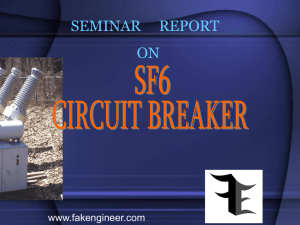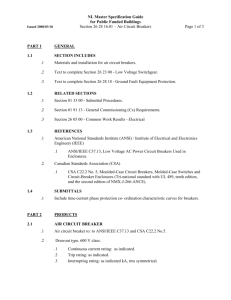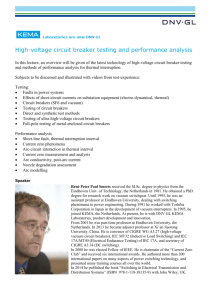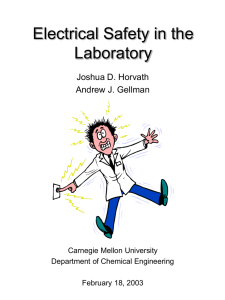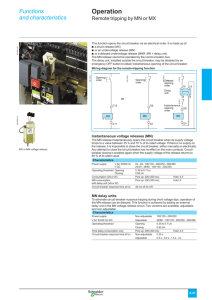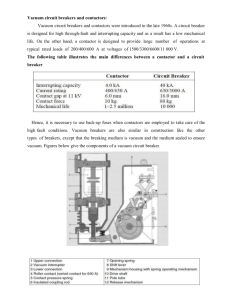circuit breakers I
advertisement
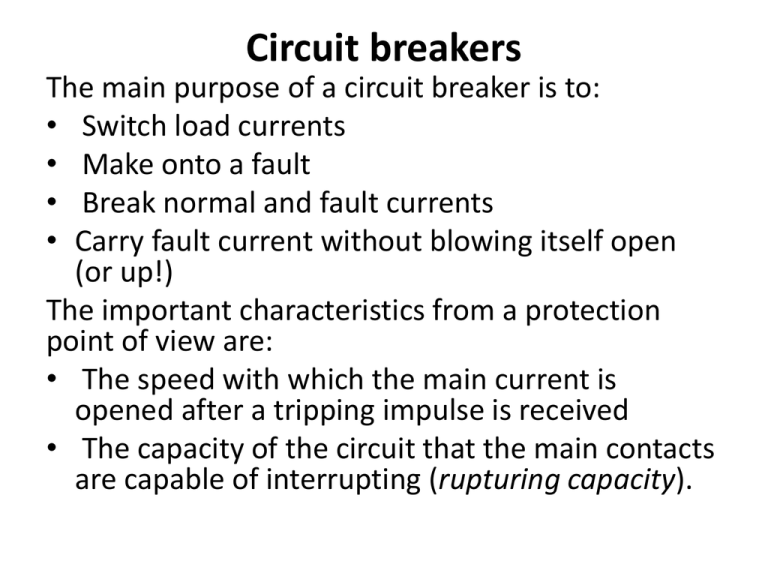
Circuit breakers The main purpose of a circuit breaker is to: • Switch load currents • Make onto a fault • Break normal and fault currents • Carry fault current without blowing itself open (or up!) The important characteristics from a protection point of view are: • The speed with which the main current is opened after a tripping impulse is received • The capacity of the circuit that the main contacts are capable of interrupting (rupturing capacity). • The first characteristic is referred to as the ‘tripping time’ and is expressed in cycles. • Modern high-speed circuit breakers have tripping times between 3 and 8 cycles. • The tripping or total clearing or break time is made up as follows: Opening time: The time between instant of application of tripping power to the instant of separation of the main contacts. Arcing time: The time between the instant of separation of the main circuit breaker contacts to the instant of arc extinction of short-circuit current. • Total break or clearing time: The sum of the above • Rupturing capacity expressed in MVA • The selection of the breaking capacity depends on the actual fault conditions expected in the system and the possible future increase in the fault level of the main source of supply. Types of circuit breakers The types of breakers basically refer to the medium in which the breaker opens and closes. The medium could be oil, air, vacuum or SF6 Arc control device • A breaker consists of moving and fixed contact, and during the breaker operation, the contacts are broken and the arc created during such separation needs to be controlled. The arc control devices, otherwise known as turbulator or explosion pot achieves this: 1. Turbulence caused by arc bubble. 2. Magnetic forces tend to force main contacts apart and movement causes oil to be sucked in through ports and squirted past gap. 3. When arc extinguished (at current zero), ionized gases get swept away and prevents restriking of the arc. • Oil circuit breakers • In modern installations, oil circuit breakers, which are becoming obsolete, are being replaced by vacuum and SF6 breakers. • The main contacts are immersed in oil and the oil acts as the ionizing medium between the contacts. The oil is mineral type, with high dielectric strength to withstand the voltage across the contacts under normal conditions. • Arc energy decomposes oil into 70% hydrogen, 22% acetylene, 5% methane and 3% ethylene. Arc is in a bubble of gas surrounded by oil. Double break oil circuit breaker Single break oil circuit breaker Oil has the following advantages: • Ability of cool oil to flow into the space after current zero and arc goes out • Cooling surface presented by oil • Absorption of energy by decomposition of oil • Action of oil as an insulator lending to more compact design of switchgear. Disadvantages: • Inflammability (especially if there is any air near hydrogen) • Maintenance (changing and purifying). Not suitable for high current interruption at low voltages due to carbonization of oil In the initial stages, the use of high-volume (bulk) oil circuit breakers was more common. In this type, the whole breaker unit is immersed in the oil. This type had the disadvantage of production of higher hydrogen quantities during arcing and higher maintenance requirements. Subsequently these were replaced with low oil (minimum oil) types, where the arc and the bubble are confined into a smaller chamber, minimizing the size of the unit. Air break circuit breaker • Interrupting contacts situated in air instead of any other artificial medium • Arc is chopped into a number of small arcs by the Arcshute as it rises due to heat and magnetic forces. • The air circuit breakers are normally employed for 380~480 V distribution. • Suitable for high current interruption at low voltages SF6 circuit Breaker (Properties of SF6 gas) Electronegative –It has the ability of an atom to attract and hold electrons. Such gas have high dielectric strength.SF6 is electronegative .It forms negative ions ,Negative ions are heavy and immobile so they do not flow easily .Hence SF6 gas has high dielectric strength. Rate of rise of dielectric strength is very high. Can be liquefied and stored in steel tanks Dielectric strength increase linearly with pressure. Gas is inert. Therefore contacts will not get eroded. Gas is non –inflammable , Colorless ,odorless, Non-toxic Thermally stable up to 55 degrees SF6 Circuit Breakers • Sulphur-hexaflouride (SF6) is an inert insulating gas, which is becoming increasingly popular in modern switchgear designs both as an insulating as well as an arc-quenching medium. • Gas insulated switchgear (GIS) is a combination of breaker, isolator, CT, PT, etc., and are used to replace outdoor substations operating at the higher voltage levels, namely 66 kV and above. • For medium- and low-voltage installations, the SF6 circuit breaker remains constructionally the same as that for oil and air circuit breakers, except for the arc interrupting chamber which is of a special design, filled with SF6. Operation of SF6 Circuit Breaker • Under normal operating conditions the contacts are closed . • On occurance of fault contacts are opened. The movable contact moves away from the fixed contact. • The arc is struck between the fixed and moving contacts. • High pressure SF6 gas now flows over the arc and it absorbs the free electrons from the arc. • This builds up the dielectric strength between the gap very fast and the arc is extinguished • To interrupt an arc drawn when contacts of the circuit breaker separate, a gas flow is required to cool the arcing zone at current interruption (i.e. current zero). • This can be achieved by a gas flow generated with a piston (known as the ‘puffer’ principle), or by heating the gas of constant volume with the arc’s energy. The resulting gas expansion is directed through nozzles to provide the required gas flow. 3/23/2016 Dr.Latif Shaikh Advantages and Disadvantages of SF6 Breaker Advantages Silent operation, compact size Very short arcing time No risk of fire No reduction in dielectric strength due to operation • Current chopping is minimized Can interrupt larger currents Suitable for explosive environment due to totally enclosed body. • Can withstand severe RRRV • Capable of breaking capacitive current without restriking • Application: for voltages ≥ 132 KV Disadvantages Costly Requires conditioning of SF6 gas from time to time SF6 gas is suffocating ,so its leakage can cause suffocation of the persons in surrounding areas. Special facilities are required for transporting gas Additional equipments are required for reconditioning Condensation at low temperature Vacuum Circuit Breakers Vacuum breakers are also similar in construction like the other types of breakers, except that the breaking medium is vacuum and the medium sealed to ensure vacuum It consists of fixed contact, moving contact and arc shield mounted inside a vacuum chamber. The movable member is connected to the control mechanism by stainless steel bellows. This enables the permanent sealing of the vacuum chamber so as to eliminate the possibility of leakage,. A glass vessel or ceramic vessel is used as outer insulating body. The arc shield prevents the deterioration of the internal dielectric strength by preventing the deterioration of the internal dielectric strength. Vacuum Circuit Breaker 3/23/2016 Dr.Latif Shaikh Working of Vacuum Circuit Breaker When two contacts of circuit breaker are separated in vacuum arc is struck and hot spots are formed on the surface of the contacts. These hot spots produce metal vapour and plasma. At current zero the rate of vapour emission becomes zero. The vapour already emitted gets condensed . During this process the dielectric strength builds up and the restriking of arc is prevented. 3/23/2016 Dr.Latif Shaikh Vacuum circuit breakers • . Advantages : • Capable of interrupting capacitive and small inductive currents without producing excessive transient over voltages • Repeated operations • Low maintenance • Silent operation • Long life • Fast dielectric recovery • Used upto 66 KV • In vacuum circuit breakers, operating speeds are also much higher which, together with contact materials that ensure high dielectric strength at a small gap, have ensured that prestrike transients have ceased to become a significant phenomenon. These have led to the use of vacuum breakers more common in modern installations. Types of mechanisms for circuit breaker • The mechanisms are required to close and break the contacts with high speed. Following are the types of mechanisms employed. 1. Hand operated: Cheap but losing popularity. Speed depends entirely on operator. Very limited use in modern installations that too for low-voltage applications only. 2. Hand operated spring assisted: Hand movement compresses spring over top dead centre. Spring takes over and closes the breaker. 3. Quick make: Spring charged-up by hand, then released to operate mechanism. 4. Motor wound spring: Motor charges spring, instead of manual. Mainly useful when remote operations are employed, which are common in modern installations because of computer applications. 5. Solenoid 6. Pneumatic: Used at 66 kV and above. Convenient when drying air is required.
